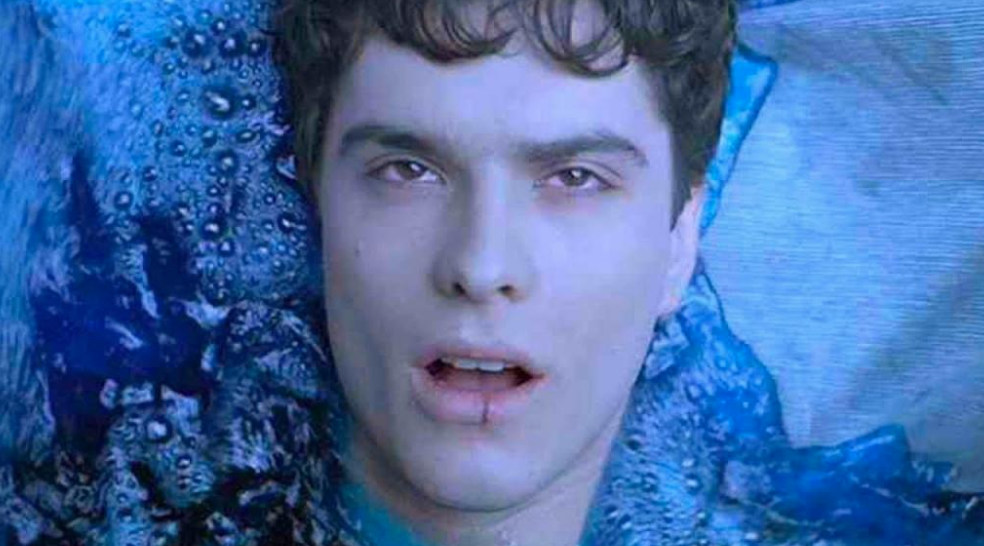[Editorial] An Intervention with Frank Henenlotter’s Brain Damage
Come with me. Let’s sit down. I’ve been worried about you. I know you think Frank Henenlotter is a director of schlock and exploitation and his movies aren’t too great. I know you find Brain Damage silly. But this, my dear, is an intervention. I only want what’s best for you. The time is now for me to explain and hope you understand that you need to face reality. Sit back and I’ll share the truth with you.
Frank Henelotter’s Brain Damage (1988), was the second feature film of his career after a long hiatus from his first film - 1982’s home video cult classic Basket Case. It is important to note that Frank Henenlotter brought his own personal experiences with drugs, specifically cocaine addiction, to put an extremely personal note on what is often considered his best film - Brain Damage. It doesn’t have the same level of cult following as Basket Case or Frankenhooker, and I believe that, itself, is a crime. Brain Damage takes the trademark Henenlotter approach to filmmaking (wild and often silly creature creation - as seen here with Elmer, very grindhouse filmmaking aesthetic, and over-the-top effects and scenes) and makes them still deliver a story with punch, pathos, and as a former drug addict myself - truth about the very nature of addiction, encased in a visceral tale that can easily be dismissed as just another Henenlotter exploitation piece.
It is important to note that our main character in Brain Damage is Brian (a very clear and simplistic anagram of “brain”) and we are not given much background on him other than him being just a regular guy living in New York City with his brother in an apartment with a serious girlfriend, Barbara. We begin with an odd sequence of an elderly couple acquiring animal brains and their seemingly strange attachment to their pet Elmer (or as the Aylmer, a creature that people have fought and died over for thousands of years, as we later find out), who has disappeared and caused them to ransack their apartment until they are literally foaming at the mouth and lying on the ground in agony. We meet our protagonist Brian, lying ill in bed from a flu awaiting his girlfriend’s arrival for a date, as Elmer does, though we as the audience don’t know this just yet. Brian begs off his date with his girlfriend Barbara, sending his brother Mike in his stead so he can recover from his flu. It is then that Elmer “introduces” himself to Brian and to the audience by attaching himself to the back of Brian’s head and injecting his brain with the “blue juice” that gives him a “high” that seems to be a combination of many drugs - LSD, cocaine, and the like. Elmer is essentially “the ultimate drug”. Brian experiences a lot of versions of the color blue, such as a flood of blue water engulfing him in calmness, hallucinations that he finds fascinating and addicting, and an overwhelming sense of “feeling good”.
Brian assumes this to be a fever dream and wakes up much later, finding blood on his pillow and attempting to understand what’s going on. It is then that we meet Elmer, voiced by former horror host and “The Cool Ghoul” John Zacherley, who gives Elmer a quirky voice that makes this absurd creature (dubbed a “turd penis” by drive-in movie critic Joe Bob Briggs; The Last Drive In on the Shudder Streaming Service, Season 2, Episode 3), a unique presence that grows on the viewer in a charming and alarming way. Even in its cartoonish voice and animated eyebrows, it manages to convey alarm and chills. It stands, to me, as a perfect voice for the “perfect” sentient drug.
It is important to note that Frank Henenelotter, screenplay writer and director of Brain Damage, developed this particularly bloody and exploitative dark tale as a direct result of his own cocaine habit, which is perhaps why it hits the nail on the head in so many astute and often gruesome ways.
“A lot of people thought Brain Damage was anti-heroin because we see this strange drug being injected into the guy but that reading is not quite true. In fact, my drug of choice was always cocaine so I had the guy ‘speeding’ more than I had him ‘downing’” - Frank Henenlotter on the messages inside Brain Damage (“Godfather of Gore: Frank Henelotter”, Dazed Magazine, May 2011).
As a former addict to prescription pills during an intense, life-threatening abusive marriage, I saw a bit of myself in Brian as he checks into a seedy motel with the intention of “detoxing” himself of Elmer and we see Brian conversing face-to-face with Elmer - a common method of treatment during drug rehabilitation. An addict must imagine their addiction sitting in the empty chair across from them and say whatever they would like to say to it, this thing that has ruined and taken over their lives. Henenlotter gives us a literal interpretation of that here and we see Brian hit withdrawal, complete with hallucinations, pain, sickness, and the addiction itself jeering at him that he, Elmer, will win in the end with our protagonist Brian.
“Ready to beg for it, Brian? Ready to crawl across the floor and plead for my juice? No? Not yet? Well, give it a few more hours, Brian. Whenever you want the pain to stop, I’ll be here. Whenever you want to stop hurting, you come to me. When the pain gets so great you think you’re turning inside out, just ask for my juice”. [Brain Damage. Directed by Frank Henenlotter, performances by Rick Hearst and Jennifer Lowry, director’s cut, Palisades Entertainment, 1988]
It’s important to stress Brian’s struggle against Elmer’s “juice” and vehement distaste of Elmer’s hunger for human brains were too huge an undertaking to go alone. Getting through any addiction alone is a setup for failure. Adversely, the addict feels so alone, they feel they cannot involve others. It’s a bit of a catch-22. I’ll even go so far as to say Brain Damage conveys the direct and distinct experience of drug addiction better than high profile addiction films such as Trainspotting and Requiem for a Dream. The beauty of horror is that filmmakers have such a world of imagination and freedom within the genre to put forth any message and it’s so very effective here and, best of all, it’s true.
I’ve been sober for more than 12 years with no relapses nor do I expect any but I keep myself open to talking about it and the commitment to honesty and that helps, plus making the hard and necessary changes to myself and my life to keep things from ever getting to that point again. Brain Damage, in its climax, conveys the very real and often true scenario of how one gets out of addiction - artfully shown in a stunning metaphor. There are humorous scenes, confusing scenes, gory scenes, and plenty of surrealism within the film, but it tells a bleak tale and is certainly a great conversation piece and think piece and absolutely deserves more praise than it gets. This has been an intervention.
If you or someone you love is struggling with addiction, here are some contacts that can help you:
SAMHSA (Substance Abuse and Mental Health Services Administration/USA) National Hotline
I-800-662-HELP (24/7, 365 days per year availability)
FRANK (UK)
0300 123 6600 (24/7 Helpline or text 82111)
My podcast, The House That Screams, did a special episode on this where I was very candid and pleased I could spread the message of the deep importance of this film and change many minds and you can find it here: The House That Screams: Brain Damage






![[Editorial] Soho Horror Film Festival: Interview with Aimee Kuge on Cannibal Mukbang](https://images.squarespace-cdn.com/content/v1/5fe76a518d20536a3fbd7246/1701808004722-9M8SZ2UXY52QBQBR4NTI/img20230818_15150780.JPG)
![[Editorial] 9 Horror Nintendo Switch Games To Play](https://images.squarespace-cdn.com/content/v1/5fe76a518d20536a3fbd7246/1697214470057-3XZXX8N4LYIMDFWS6Z3P/Screenshot+2023-10-13+at+17.20.13.png)
![[Mother of Fears] Mothering in Silence in A Quiet Place (2018)](https://images.squarespace-cdn.com/content/v1/5fe76a518d20536a3fbd7246/1696445921315-HZJ2DZYQIH6VVWXBO2YL/Screenshot+2023-10-04+at+19.52.29.png)
![[Event Review] Highlights from Mayhem Film Festival 2023](https://images.squarespace-cdn.com/content/v1/5fe76a518d20536a3fbd7246/1697624582491-MPT2VB9RRGU6OG7L6UKL/Mayhem+2023.jpg)
![[Editorial] Mayhem Festival: Interview with Thomas Sainsbury on Loop Track (2023)](https://images.squarespace-cdn.com/content/v1/5fe76a518d20536a3fbd7246/1697186472899-WC4RR0TW7L7LMFEBGPA2/Tom+Sainsbury.jpg)
![[Editorial] Keeping Odd Hours: A Retrospective on Near Dark (1987)](https://images.squarespace-cdn.com/content/v1/5fe76a518d20536a3fbd7246/1696445070868-HU9YIL3QPBCL1GW47R3Z/Screenshot+2023-10-04+at+19.36.53.png)
![[Editorial] 5 Female Focused Horror Book Recommendations](https://images.squarespace-cdn.com/content/v1/5fe76a518d20536a3fbd7246/1696441981361-52EQCTJ7AT2QF1927GM7/919xtm6d3fL._AC_UF894%2C1000_QL80_.jpg)
![[Editorial] What to Watch at This Year's Cine-Excess International Film Festival 2023](https://images.squarespace-cdn.com/content/v1/5fe76a518d20536a3fbd7246/1697213510960-REV43FEOZITBD2W8ZPEE/Screenshot+2023-10-13+at+17.01.15.png)
![[Editorial] Cherish Your Life: Comfort in the SAW Franchise Throughout and Beyond the COVID-19 Pandemic](https://images.squarespace-cdn.com/content/v1/5fe76a518d20536a3fbd7246/1695487675334-MYPCPYYZQZDCT548N8DI/Sc6XRxgSqnMEq54CwqjBD5.jpg)























![[Editorial] 10 Films & Events to Catch at Soho Horror Film Fest 2023](https://images.squarespace-cdn.com/content/v1/5fe76a518d20536a3fbd7246/1700819417135-299R7L4P0B676AD3RO1X/Screenshot+2023-11-24+at+09.41.52.png)
![[Editorial] 9 Best Slashers Released Within 10 Years of Scream (1996)](https://images.squarespace-cdn.com/content/v1/5fe76a518d20536a3fbd7246/1695478839037-LOFHGVM3H6BMSZW7G83M/Screenshot+2023-09-23+at+15.15.11.png)
![[Mother of Fears] Mother Vs. Monster in Silent Hill (2006)](https://images.squarespace-cdn.com/content/v1/5fe76a518d20536a3fbd7246/1695485781119-H6GNP0G3J2TLPAOIABV7/Screenshot+2023-09-23+at+17.11.56.png)
![[Editorial] 9 Terrifying Cerebral Visions in Horror Movies](https://images.squarespace-cdn.com/content/v1/5fe76a518d20536a3fbd7246/1693509801235-X23OL50T1DVGECH0ZJK2/MV5BMjQ0MTg2MjQ4MV5BMl5BanBnXkFtZTgwMTU3NDgxMTI%40._V1_.jpg)
![[Mother of Fears] I Don’t Wanna Be Buried in a Pet Sematary (1989) and (2019)](https://images.squarespace-cdn.com/content/v1/5fe76a518d20536a3fbd7246/1691328766069-QFNAVJOMFZVZ5CLU1RWM/Screenshot+2023-08-06+at+14.23.13.png)
![[Mother of Fears] How I Love to Love Nadine in The Stand (2020)](https://images.squarespace-cdn.com/content/v1/5fe76a518d20536a3fbd7246/1690213172707-TKM9MZXK02EVCIX30M1V/Screenshot+2023-07-24+at+16.29.11.png)
![[Editorial] 11 Best Werewolf Transformations in Horror Films](https://images.squarespace-cdn.com/content/v1/5fe76a518d20536a3fbd7246/1689240234098-HUPQC6L57AAHFJNT8FTE/Screenshot+2023-07-13+at+10.09.13.png)

Now it’s time for Soho’s main 2023 event, which is presented over two weekends: a live film festival at the Whirled Cinema in Brixton, London, and an online festival a week later. Both have very rich and varied programmes (with no overlap this year), with something for every horror fan.